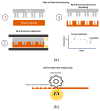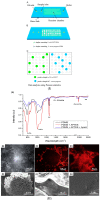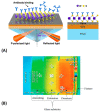Polymeric and Paper-Based Lab-on-a-Chip Devices in Food Safety: A Review
- PMID: 37241610
- PMCID: PMC10223399
- DOI: 10.3390/mi14050986
Polymeric and Paper-Based Lab-on-a-Chip Devices in Food Safety: A Review
Abstract
Food quality and safety are important to protect consumers from foodborne illnesses. Currently, laboratory scale analysis, which takes several days to complete, is the main way to ensure the absence of pathogenic microorganisms in a wide range of food products. However, new methods such as PCR, ELISA, or even accelerated plate culture tests have been proposed for the rapid detection of pathogens. Lab-on-chip (LOC) devices and microfluidics are miniaturized devices that can enable faster, easier, and at the point of interest analysis. Nowadays, methods such as PCR are often coupled with microfluidics, providing new LOC devices that can replace or complement the standard methods by offering highly sensitive, fast, and on-site analysis. This review's objective is to present an overview of recent advances in LOCs used for the identification of the most prevalent foodborne and waterborne pathogens that put consumer health at risk. In particular, the paper is organized as follows: first, we discuss the main fabrication methods of microfluidics as well as the most popular materials used, and then we present recent literature examples for LOCs used for the detection of pathogenic bacteria found in water and other food samples. In the final section, we summarize our findings and also provide our point of view on the challenges and opportunities in the field.
Keywords: fabrication techniques; food safety; lab on a chip; microfluidics; paper-based; pathogen detection; polymer-based; water safety.
Conflict of interest statement
The authors declare no conflict of interest.
Figures
















Similar articles
-
Lab-on-a-chip pathogen sensors for food safety.Sensors (Basel). 2012;12(8):10713-41. doi: 10.3390/s120810713. Epub 2012 Aug 6. Sensors (Basel). 2012. PMID: 23112625 Free PMC article. Review.
-
Microfluidic devices for multiplexed detection of foodborne pathogens.Food Res Int. 2021 May;143:110246. doi: 10.1016/j.foodres.2021.110246. Epub 2021 Feb 26. Food Res Int. 2021. PMID: 33992358 Review.
-
Design, fabrication and assembly of lab-on-a-chip and its uses.Prog Mol Biol Transl Sci. 2022;187(1):121-162. doi: 10.1016/bs.pmbts.2021.07.021. Epub 2021 Sep 2. Prog Mol Biol Transl Sci. 2022. PMID: 35094773
-
State-of-the-art advancements in Liver-on-a-chip (LOC): Integrated biosensors for LOC.Biosens Bioelectron. 2022 Dec 15;218:114758. doi: 10.1016/j.bios.2022.114758. Epub 2022 Sep 28. Biosens Bioelectron. 2022. PMID: 36201998 Review.
-
Recent advancements in microfluidic chip biosensor detection of foodborne pathogenic bacteria: a review.Anal Bioanal Chem. 2022 Apr;414(9):2883-2902. doi: 10.1007/s00216-021-03872-w. Epub 2022 Jan 21. Anal Bioanal Chem. 2022. PMID: 35064302 Free PMC article. Review.
Cited by
-
Advances in textile-based microfluidics for biomolecule sensing.Biomicrofluidics. 2024 Sep 17;18(5):051502. doi: 10.1063/5.0222244. eCollection 2024 Sep. Biomicrofluidics. 2024. PMID: 39296324 Free PMC article. Review.
-
Emerging trends in nano-sensors: A new frontier in food safety and quality assurance.Heliyon. 2024 Dec 12;11(1):e41181. doi: 10.1016/j.heliyon.2024.e41181. eCollection 2025 Jan 15. Heliyon. 2024. PMID: 39807502 Free PMC article. Review.
-
Integrated Plastic Microfluidic Device for Heavy Metal Ion Detection.Micromachines (Basel). 2023 Aug 13;14(8):1595. doi: 10.3390/mi14081595. Micromachines (Basel). 2023. PMID: 37630131 Free PMC article.
-
Innovations in graphene-based electrochemical biosensors in healthcare applications.Mikrochim Acta. 2025 Apr 9;192(5):290. doi: 10.1007/s00604-025-07141-w. Mikrochim Acta. 2025. PMID: 40205234 Free PMC article. Review.
-
Microfluidic Paper-Based Devices.Micromachines (Basel). 2025 Mar 6;16(3):307. doi: 10.3390/mi16030307. Micromachines (Basel). 2025. PMID: 40141918 Free PMC article.
References
-
- Sedighi A., Li P.C. Challenges and Future Trends in DNA Microarray Analysis. Compr. Anal. Chem. 2014;63:25–46. doi: 10.1016/B978-0-444-62651-6.00002-7. - DOI
-
- Ghallab Y., Badawy W. Sensing methods for dielectrophoresis phenomenon: From bulky instruments to lab-on-a-chip. IEEE Circuits Syst. Mag. 2004;4:5–15. doi: 10.1109/MCAS.2004.1337805. - DOI
-
- Weng X., Neethirajan S. Ensuring food safety: Quality monitoring using microfluidics. Trends Food Sci. Technol. 2017;65:10–22. doi: 10.1016/j.tifs.2017.04.015. - DOI
Publication types
LinkOut - more resources
Full Text Sources
Miscellaneous

